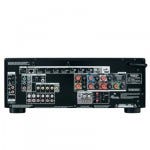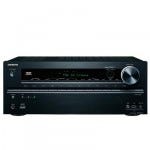
If you have never owned an AV Receiver (often called an amplifier), you may wonder what all the fuss is about. Once you have owned one, you will understand how valuable they are to your Home Theatre or audio set up and how you can get the most out of your entertainment equipment when you adopt one.
The receiver is essentially a “Hub” or a big “Switch” to help you manage the various devices you may have or hope to get in the future. It allows you to connect every piece of your audio visual equipment such as your BluRay and DVD players, game console, iPod or video camera through the “Hub” and amplify the audio through your speakers and send the video signal to your screen, whether a computer monitor, television or projector, it doesn’t matter.
As our home entertainment options have grown, so has the role of the receiver. They have evolved to handle a wide variety of digital audio signals and video switching to simplify changing between devices. With rapid growth in technology, AV receivers now have greater functionality than found in models even 5-10 years ago.
The primary role of your receiver is to amplify and drive your surround sound speaker system. With multiple channels of amplification possible in today’s models, the minimum standard is usually five channels. Usually referred to as 5.1 receivers, this provides power for a left, right, centre, left surround and right surround speaker. If you’re looking at a 7.1 receiver, this model provides for two additional surround channels, left rear surround and right rear surround. The “.1” refers to the line level output provided to be sent to an amplified subwoofer. Read our blog on subwoofers
The audio format from a source (DVD, BluRay etc) is decoded by surround sound processing technology within the AV receiver. Receivers often have two or more decoders within them and some common ones which you may have heard of are Dolby Pro Logic, DTS and Audyssey. This is to ensure that your DVD, CD or source data is processed correctly and sent to the appropriate speakers, as intended by the Sound Engineers when they recorded the information.
There are several possible input and output connections you can make via your AV receiver, including analog audio, digital audio, HDMI, Ethernet and more. Read our blog about all the inputs behind your receiver, to find out how they work together.
Added features on some receivers
Upscaling - Some receivers also have the ability to “upscale”. With an upscaling receiver, all video sources are run into the receiver, and a single HDMI (or component) video cable is run to the TV. The TV is left on the HDMI input all the time, and the user selects the source for both audio AND video on the receiver. This means that switching between multiple video sources becomes much simpler, and quality can improve when it upscales the video sources from standard-definition video (VHS & laser disc players) to high-definition video.
3D Pass Through - When a receiver is described as having pass-through capability, it means that the audio or video can exit exactly as it entered, without alteration. 3D pass-through capability means you can watch 3D movies from your Blu-ray Disc player on your 3D HDTV set with surround sound, because the receiver passes the 3D signal through from your Blu-ray player to your TV through HDMI ports that support HDMI 1.4 for 3D. Older receivers may block the 3D constituent in the video data from passing through. In the latter scenario, your choice is 3D without surround sound or 2D with surround sound.
Multi-Zone Audio - Multi-Zone capability is a function in which the receiver can send another signal to speakers or a separate audio system in another location. This is not the same as connecting additional speakers and placing them in another room. The Multi-Zone function allows your receiver to control either the same, or a separate, source than the one being listened to in the main room, in another location. For example, you can be watching a DVD in the lounge room, while someone else can listen to a CD in the kitchen, at the same time. Both the DVD player and CD player are controlled by the same receiver.
Networking and Internet Audio/Video Streaming - Networking is a feature that is now found in more home theatre receivers using an integrated ethernet input. Not all networking receivers are the same, but common functions include streaming audio and/or video from your computer or the internet, internet radio, and the ability to update firmware directly from the internet.
Control your receiver from your phone – With the evolution of smart phones, apps have been created by many manufacturers which allow you to turn your Android or iPhone into a remote control. This lets you use your set up from anywhere in the house.
Keep in mind when looking into buying your first receiver or upgrading, that not all models are the same. Receivers today are as much about video as they are about audio, so check out all the features within and think about the components you will be connecting to your system.
Shop Receivers online or Speak to one of our Selby Techs for help setting up your own system.








